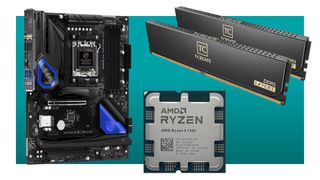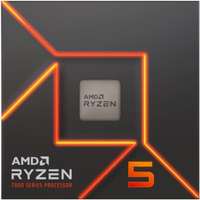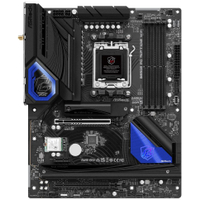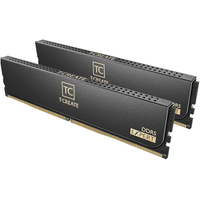Don't fancy a Prime Day pre-built? This is how I would upgrade a gaming PC platform for under $460
Breath new life into an ageing PC with a speedy CPU, feature-rich motherboard, and fast DDR5 RAM.

There comes a time for every PC gaming enthusiast when the rig no longer cuts the mustard. The CPU is too slow or doesn't have enough cores, the motherboard doesn't support the latest SSDs, and the machine runs out of memory far too often. The only cure is a full system upgrade but that's really expensive, right?
Well, thanks to the Prime Day sales bonanza, it's honestly not and although bundles like this are normally the preserve of Micro Center, not everyone lives near a store. This CPU, motherboard, and RAM combination will give you an excellent foundation with which to build a long-lasting and upgradable gaming PC.
You'll need to keep your old case, graphics card, storage, and power supply unit but with a fresh platform, you'll be able to update the other components when you can in the future.
Quick links
- AMD Ryzen 5 7600 - $197.89 at Amazon (save $31.02)
- ASRock B650E PG Riptide - $174.99 at Newegg (save $65)
- Team Group DDR5-6000 - $85.99 at Amazon (save $7)
AMD Ryzen 5 7600
AMD Ryzen 5 7600 | 6 cores, 12 threads | AM5 socket | 5.1 GHz boost | 32 MB L3 cache | 65 W | $229 $197.98 at Amazon (save $31.02)
Six-core CPUs are still perfectly fine for gaming and AMD's little Zen 4-powered Ryzen 5 7600 is a great choice for anyone looking to build a cheap AM5 gaming PC. It sips power, making it easy to cool, and will serve you well for years.
Ryzen 5 7600 price check: Newegg $198
AMD's recent Ryzen 9000-series of processors might seem to be the ones to go for but given that they're not much faster than their predecessors, the sensible choice is a 7000-series chip. Models like a Ryzen 7 7800X3D are very pricey, but you don't have to sacrifice bags of performance when you're on a budget.
The Ryzen 5 7600 is a six-core, 12-thread processor, with a boost clock of 5.1 GHz. Unlike many 'budget' CPUs, this one isn't hamstrung by having a reduced amount of L3 cache and it's not locked from overclocking, either.
It even comes with an AMD Wraith Stealth cooler and while it's not the best you can buy, at least you don't need to worry about getting an additional cooler to go with this bundle.
The best thing about this CPU is that the motherboard it will go into not only supports any Ryzen 7000-series chip but also the new 9000 range and at least another generation after that. So if you do feel the need for a bit more speed in the coming years, swapping it over is a piece of cake.
ASRock B650E PG Riptide
ASRock B650E PG Riptide | AM5 socket | 3x PCIe slots | 3x M.2 slots | 10x USB ports rear IO | $239.99 $174.99 at Newegg (save $65)
This AM5 motherboard is the perfect way to build that you can upgrade over the years. With three M.2 slots and four SATA ports, you're sorted for storage and there's a small mountain of USB ports, too. And you've got a Wi-Fi 6E module, along with 2.5G Ethernet. What's not to like?
ASRock B650E price check: Amazon $189.99
If you're going to choose a motherboard that will last you for many years but you don't want to spend a fortune, then this ASRock B650M PG Riptide is hard to beat. It fully supports any AM5 socket processor, even the hulking Ryzen 9 7950X3D or Ryzen 9 9950X, thanks to having 14 VRMs for the CPU, each rated at 60 A. That's more than enough juice for any Ryzen chip.
You get three PCIe slots—x16 Gen 5, x16 Gen 3, x1 Gen 4—plus three M.2 slots for SSDs. The topmost one is a full-speed Gen 5 slot and while it's not worth spending the money on a PCIe 5.0 SSD just yet, they will come down in price and heat in the future. The other M.2 slots are a full-speed Gen 4 and a half-speed Gen 3.
That's not as well equipped as more expensive motherboards but you will be able to fit any graphics cards in there, plus two big and fast SSDs for Windows and your Steam library.
What really sells the ASRock B650M PG Riptide is the fact that the rear IO panel boasts 10 USB ports—six USB 2.0 Type A, two USB 3.1 Gen1 Type A, one USB 3.1 Gen2 Type A and a Gen 2 Type C. There are headers on the board for a further six USB ports, too.
Add in the Wi-Fi 6E module and 2.5G Ethernet port, and you've all the connectivity options you could possibly want. Yes, some ultra-fast USB ports would be nice but you'll need to pay a pretty penny to get them.
Team Group DDR5-6000 32 GB CL30 kit
Team Group T-Create Expert | 32 GB (2x16) | 6,000 MT/s | CAS 30 | $92.99 $85.99 at Amazon (save $7)
The sweet spot for AMD Ryzen CPUs is DDR5-6000 and this kit from Team Group is both fast and affordable. It's not flashy but it does exactly what you need it to without any fuss.
Team Group DDR5-6000 price check: Newegg $85.99
The final component you'll need for an AM5 system upgrade is RAM, especially if you're coming from an older setup that uses DDR4. For AMD Ryzen chips, you'll get the best performance from the processor if you pair it with a dual-channel DDR5-6000 kit and this Team Group offering is just the ticket.
You'd expect it to have slow timings at this price but CL30-36-36-76 is not to be sniffed at, and you certainly won't have any complaints about the RAM's speed. What you're not getting, of course, is any nice RGB lighting, just a decent metal heatsink to help the DRAM chips stay cool.
All together, this CPU, motherboard, and RAM combination comes in at a little under $460. You can buy a full gaming PC for less than this but you won't be able to upgrade it in the future. Get this bundle, pop it into your old case, and you'll be sorted—now put the cash you've saved towards a shiny new graphics card. Huzzah for sales!
The biggest gaming news, reviews and hardware deals
Keep up to date with the most important stories and the best deals, as picked by the PC Gamer team.

Nick, gaming, and computers all first met in 1981, with the love affair starting on a Sinclair ZX81 in kit form and a book on ZX Basic. He ended up becoming a physics and IT teacher, but by the late 1990s decided it was time to cut his teeth writing for a long defunct UK tech site. He went on to do the same at Madonion, helping to write the help files for 3DMark and PCMark. After a short stint working at Beyond3D.com, Nick joined Futuremark (MadOnion rebranded) full-time, as editor-in-chief for its gaming and hardware section, YouGamers. After the site shutdown, he became an engineering and computing lecturer for many years, but missed the writing bug. Cue four years at TechSpot.com and over 100 long articles on anything and everything. He freely admits to being far too obsessed with GPUs and open world grindy RPGs, but who isn't these days?
Most Popular










